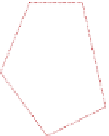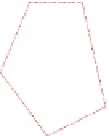Biomedical Engineering Reference
In-Depth Information
is shown below, which has two fatty acid groups, one glycerol group, and one phosphate
group.
R
1
R
1
Fatty acid
1
O
Glycerol
O
O
R
2
R
2
Fatty acid
2
O
O
HO
P
O
O
Stero structure of phospholipids
Another class of lipids of increasing technological importance is the polyhydroxyalka-
noates (PHA). PHA's are polyesters formed by ester bonds end-to-end with hydroxyl group
and carboxylic acid group. This natural polymer can be developed to replace existing poly-
mers. In particular, polyhydroxybutyrate (PHB) is a good example of PHA. It can be used to
form a clear, biodegradable polymeric sheet. Polymers with a variety of PHAs are being
commercially developed. In some cells, PHB is formed as a storage product, much like fat
in animals.
R
O
O
O
H
H
H
O
OH
O
OH
n
O
OH
n
n
(
P
A
)
(
P
V
)
(
P
B
:
p
o
l
y
-
3
-
h
y
d
r
o
x
y
b
u
t
y
r
i
c
a
i
d
)
O
O
H
OH
O
O
n
(PHBV: poly-3-hydroxybutyric acid-co-3-hydroxyvaleric acid)
Steroids can also be classified as lipids. Naturally occurring steroids are hormones
that are important regulators of animal development and metabolism at very low concen-
trations (for example, 10
8
mol/L). A well-known steroid, cholesterol, is present in
membranes of animal tissues.
Figure 2.29
depicts the structures of some important steroids.
Cortisone is an anti-inflammatory used to treat rheumatoid arthritis and some skin
diseases. Derivatives of estrogens and progesterone are used as contraceptives. The
commercial production of steroids is very important and depends on microbial conver-
sions. Because of the large number of asymmetric centers, the total synthesis of steroids
is difficult. Plants provide a source of abundant lipid precursors for these steroids, but
the highly specific hydroxylation of these substrates at positions 11 (and 16) or dehydroge-
nations at position 1 are necessary to convert the precursors into compounds similar to
those made in the adrenal gland. This cannot be done easily with chemical means and is
done commercially using microbes that contain enzymes mediating specific hydroxylations
or dehydrogenations.





































































































Search WWH ::

Custom Search